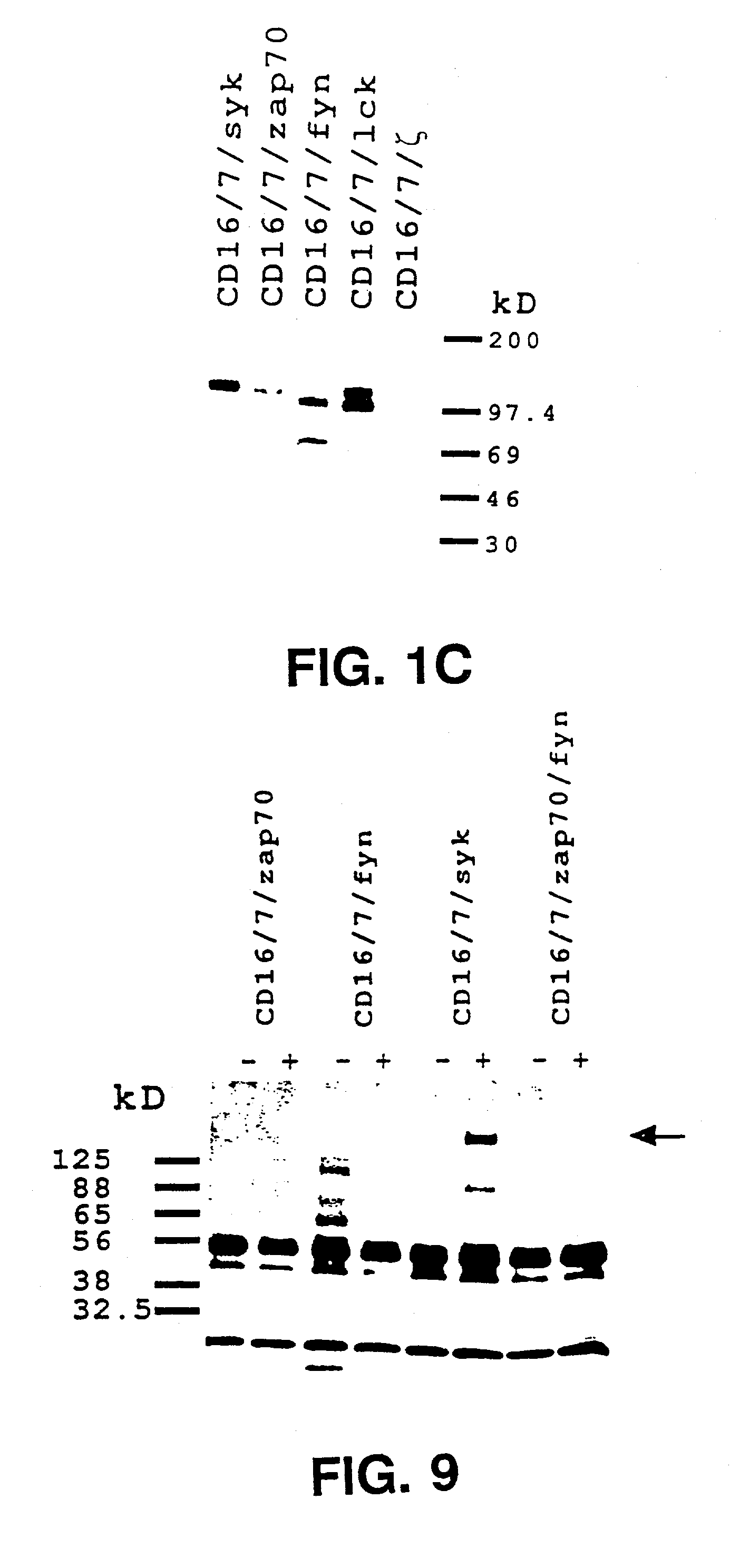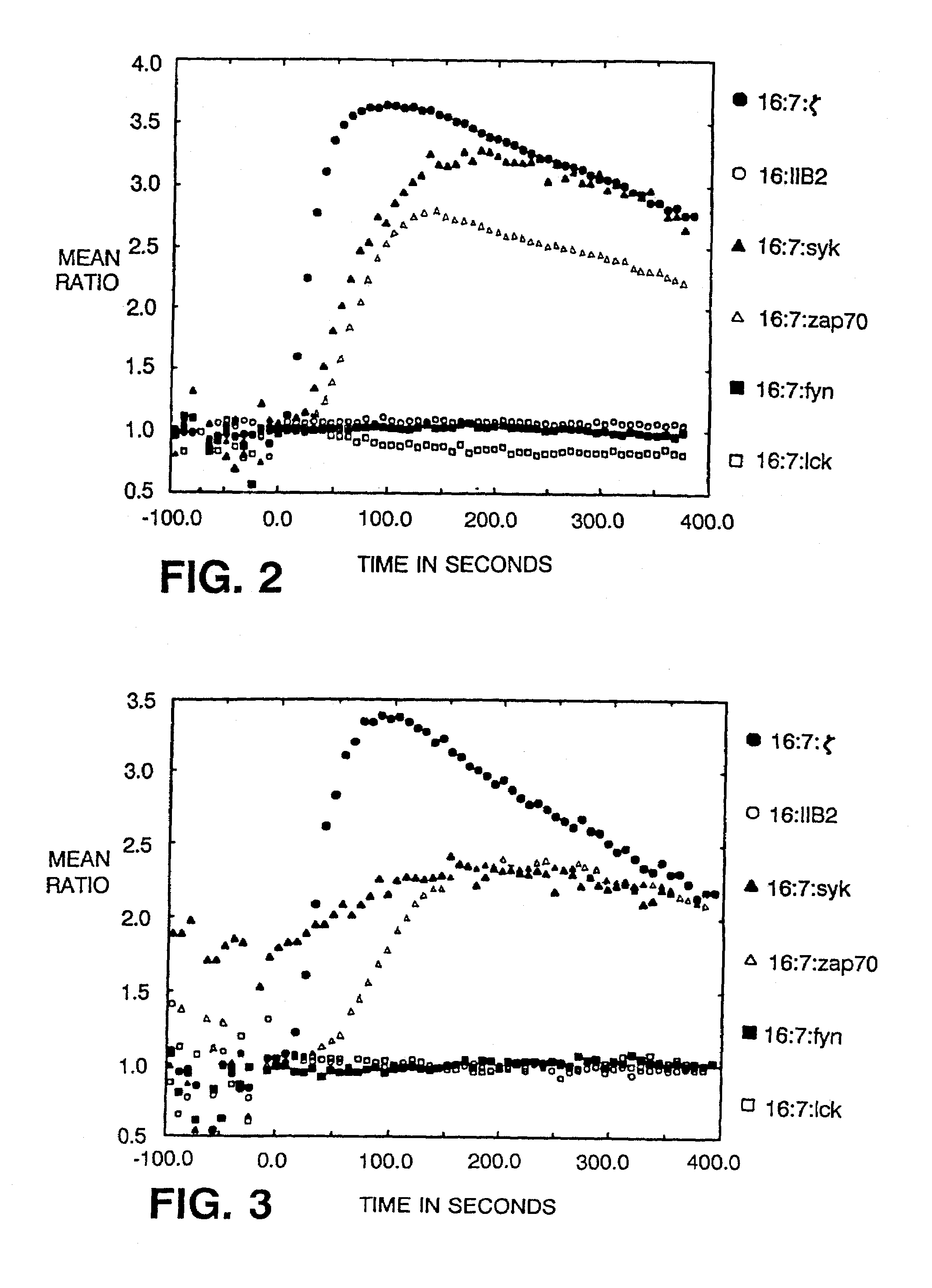[0029]The present invention demonstrates the feasibility of creating chimeras between the
intracellular domain of a
protein-
tyrosine kinase molecule and an
extracellular domain which is capable of fulfilling the task of target recognition. In particular, clustering of chimeras bearing
Syk or ZAP-70 kinase sequences triggers
calcium mobilization. Aggregation of
Syk chimera alone, or coaggregation of chimeras bearing Fyn or Lck and ZAP-70 kinases, suffices to initiate cytolytic
effector function. Such
effector function facilitates the specific recognition and destruction of undesirable target cells, for example, pathogens, pathegen-infected cells,
tumor cells, or autoimmune cells.
[0031]Although these examples draw on the use of
antibody chimeras as a convenient expository tool, the invention is not limited in scope to
antibody chimeras, and indeed, the use of specific nonantibody
extracellular domains may have important advantages. For example with an extracellular portion that is the receptor for a
virus, bacterium, or parasite, cells armed with the chimeras would specifically target cells expressing the viral, bacterial or parasitic determinants. The
advantage of this approach over the use of antibodies is that the native receptor for
pathogen may have uniquely
high selectivity or affinity for the
pathogen, allowing a greater
degree of precision in the resulting immune response. Similarly, to delete
immune system cells which inappropriately react with a self
antigen, it may suffice to join the antigen (either as an
intact protein, in the case of
B cell depletion therapies, or as MHC complex, in the case of
T cell depletion therapies) to
intracellular protein-tyrbsine kinase chains, and thereby affect the specific targeting of the cells inappropriately responding to self determinants.
[0048]By “
functional derivative” is meant the “fragments,”“variants,”“analogues,” or “chemical derivatives” of a molecule. A “fragment” of a molecule, such as any of the cDNA sequences of the present invention, is meant to refer to any
nucleotide subset of the molecule. A “variant” of such molecule is meant to refer to a naturally occurring molecule substantially similar to either the entire molecule, or a fragment thereof. An “analog” of a molecule is meant to refer to a non-natural molecule substantially similar to either the entire molecule or a fragment thereof. A molecule is said to be “substantially similar” to another molecule if the sequence of amino acids in both molecules is substantially the same. Substantially similar
amino acid molecules will possess a similar
biological activity. Thus, provided that two molecules possess a similar activity, they are considered variants as that term is used herein even if one of the molecules contains additional or fewer
amino acid residues not found in the other, or if the sequence of
amino acid residues is not identical. As used herein, a molecule is said to be a “chemical derivative” of another molecule when it contains additional chemical moieties not normally a part of the molecule. Such moieties may improve the molecule's
solubility, absorption,
biological half life, etc. The moieties may alternatively decrease the
toxicity of the molecule, eliminate or attenuate any undesirable
side effect of the molecule, etc. Moieties capable of mediating such effects are disclosed, for example, in Remington's
Pharmaceutical Sciences, 16th et., Mack Publishing Co., Easton, Pa. (1980).
[0059]Antibodies against the chimera according to the present invention may be used to monitor the amount of chimeric receptor (or chimeric receptor-bearing cells) in a patient. Such antibodies are well suited for use in standard immunodiagnostic
assay known in the art, including such immunometric or “sandwich” assays as the forward sandwich, reverse sandwich, and simultaneous sandwich assays. The antibodies may be used in any number of combinations as may be determined by those of skill without undue experimentation to effect immunoassays of acceptable specificity, sensitivity, and accuracy.
[0071]Likewise, a bioluminescent compound may be used to
label the antibodies according to the present invention.
Bioluminescence is a type of
chemiluminescence found in biological systems in which a catalytic protein increases the efficiency of the chemiluminescent reaction. The presence of a bioluminescent
antibody is determined by detecting the presence of
luminescence. Important bioluminescent compounds for purposes of labeling include
luciferin,
luciferase aequorin.
[0089]By “MHC-independent” is meant that the cellular cytolytic response does not require the presence of an
MHC class II antigen on the surface of the targeted cell.
 Login to View More
Login to View More  Login to View More
Login to View More 


